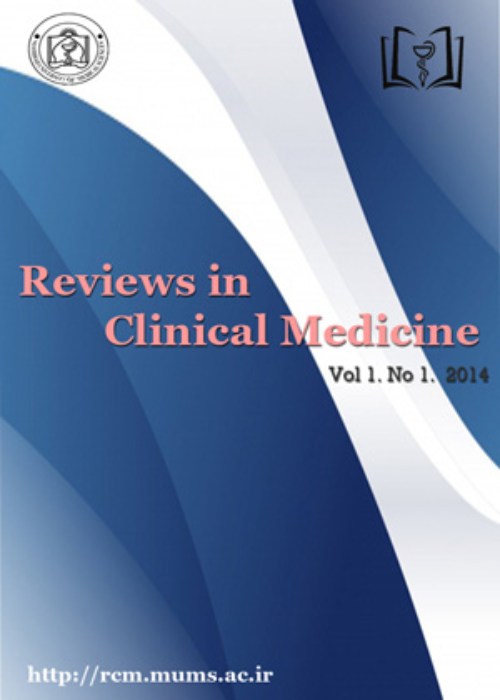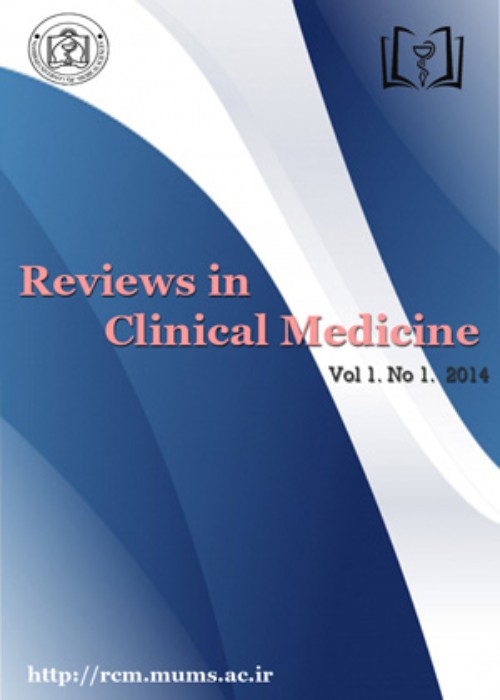فهرست مطالب

Reviews in Clinical Medicine
Volume:9 Issue: 4, Autumn 2022
- تاریخ انتشار: 1401/12/27
- تعداد عناوین: 8
-
Pages 156-158IntroductionEpidermolysis bullosa is a genetic condition with skin fragility that leads to blister formation and erosion following minor trauma. This disease also involves the gastrointestinal tract by way of esophageal stricture and dysphasia. Some studies have recommended oral budesonide liquid therapy to decrease the need for balloon endoscopy and other aggressive treatments. The aim of the study was to evaluated clinical symptoms of patients who consumed oral budesonide in their daily routine therapies.MethodsThis cross-sectional study was conducted in Akbar Hospital of the Mashhad University of Medical Sciences. All enrolled patients were followed between July and October 2021. Ten milliliter oral budesonide (0.5 milligram) liquid was administrated one hour before eating. They were followed up to determine and document any side effects after treatment, and any improvement of clinical symptoms such as amelioration of dysphasia, volume of food intake, duration of food consumption, and kind of food consumed (solid versus liquid).ResultsAbout fifteen patients were studied. The mean duration + SD of using budesonide was 9.66±15.76 weeks. The mean percentage + SD was 41.33±34.61 for improvement in the volume of food intake, and the mean for improving dysphasia + SD was 42±33.63%. Three patients suffered from complications (i.e., mucositis and gastric fullness). Also, two patients did not want to continue treatment because they did not like the drug taste.ConclusionOral budesonide liquid could be recommended for epidermolysis bollusa patients to improve clinical symptoms.Keywords: budesonide, Epidermolysis bollusa, Oral, liquid, Dysphagia
-
Pages 159-171
The genus Raoultella is still understudied compared to other Enterobacteriaceae members. However, there are numerous published case reports on Raoultella infections. The genetic closeness of Raoultella spp. and Klebsiella spp. may lead to misidentification using conventional microbiology methods. The prevalence of this bacterium in clinical settings can vary geographically. Our knowledge of its resistome evolution contributing to Raoultella antibiotic resistance is also limited to a few characterized genes. This review summarises the current knowledge on Raoultella genetic and microbiology aspects, its identification methods, virulence factors, clinical manifestations, and so on. This combined information highlights the gaps in our understanding of Raoultella pathogenesis, resistome, and vaccine suggesting future research directions. The diversity and plasticity of the antibiotic resistance plane of Raoultella species have determined the early and precise identification of Raoultella infection is very important to improve the prognosis of the clinical infections and to control the spread of this bacterium. According to our literature review results, patients with multiple congenital abnormalities are susceptible to Raoultella infection. Tumours, immune deficiency, and invasive operations increase the risk of infection.
Keywords: Raoultella species, Klebsiella oxytoca, Raoultella planticola, Laboratory identification -
Pages 172-176
Polycystic ovary syndrome (PCOS) is the most common endocrinological disorder in women of reproductive age. Several studies have shown that inflammation factors have a crucial role in the function of the ovary as ovarian dysfunction can be caused by an imbalance of pro-inflammatory cytokines. Other studies have shown that PCOS patients have high levels of pro-inflammatory cytokines such as tumor necrosis factor-alpha (TNF-α), c-reactive protein (CRP(, interleukin-6 )IL-6(, and interleukin-8 (IL-8). Inflammation can be caused by a variety of factors including diet, and diet-induced inflammation can contribute to insulin resistance and atherogenesis as well as ovulation problems in women with PCOS. It is possible to calculate the components of diet and inflammation caused by diet using many different indices. The Healthy Eating Index (HEI) and Dietary Inflammatory Index (DII) are relatively new indices. As HEI is the overall health index for diet and DII indicates the inflammatory index of the diet, it is possible that a person’s diet can be generally healthy but has a high risk of inflammation, so these two indices should be considered together. Furthermore, dietary management of PCOS patients can reduce hyperinsulinemia, hyperandrogenism, and inflammation, which in turn helps to control and reduce disease complications such as infertility.
Keywords: Dietary health index, Dietary inflammatory index, Inflammation, Polycystic ovary syndrome -
Pages 177-180
Meningitis is a clinical syndrome that occurs for a variety of reasons such as bacterial infections. Acute bacterial meningitis can occur at any age, and is a leading cause of mortality worldwide. Streptococcus pneumonia is a bacterial meningitis that can lead to pneumococcal meningitis, especially in children. In recent decades, the percentage of pneumococcal strains resistant to penicillin and cephalosporins isolated from children has increased. This has made vancomycin the first empirical antibiotic therapy for children with suspected bacterial meningitis.In this report, we introduce a 13-month-old child who was brought to the emergency department of Akbar Children’s Hospital, Mashhad (a city in northeastern Iran) with complaints of high-grade fever and drowsiness. Meningitis was diagnosed via sampling of cerebrospinal fluid, and the culture indicated S. pneumonia that was non-sensitive to vancomycin. The e-test and microdilution have been approved to determine the minimum inhibitory concentration (MIC) of vancomycin; however, the e-test is a more straightforward method and the error probability is less while providing similar results to microdilution. Also, both methods can predict vancomycin tolerance or reduce sensitivity to vancomycin. Results of the e-test indicate MIC=2.
Keywords: Bacterial meningitis, Empiric Therapy, pneumococcal meningitis, vancomycin-tolerant S. pneumonia -
Pages 181-185
SV (sodium valproate) is an antiepileptic drug that is often prescribed for epilepsy, bipolar disorders, and migraine. We reported an SV intoxicated case that cardiac and neurologic abnormalities were promptly responded to hemodialysis (HD). She ingested a large amount of SV (150 pills of SV 200mg) for a suicide attempt. She was initially alert but her Glasco coma scale (GCS) decreased to 6 thought 11 hours. However, valproate (>150mg/l) and ammonia serum (164µg/dL) levels were not excessively elevated. The serial electrocardiography (ECG) showed QT prolongation and a signs of sodium channel block such as dominant R wave in AVR lead and T-wave inversion in the precordial leads. She had low level of calcium and potassium serum levels. Supportive treatment, charcoal, and L-carnitine, were not effective and HD was started due to the resistant cardiac and neurologic symptoms. After a 3-hour HD session, decreased GCS, pathological ECG findings, and laboratory abnormalities dramatically disappeared. In conclusion, HD is an effective and rapid response treatment for Valproate-induced loss of consciousness and life-threatening cardiac abnormality.
Keywords: hemodialysis, Valproate Poisoning, Cardiac Manifestations, Neurologic manifestations -
Pages 186-195IntroductionAmong various proposed pathologic mechanisms during the coronavirus disease 2019 (COVID-19) pandemic, overproduction of autoantibodies is not widely studied. Antiphospholipid antibodies (aPLs) are target proteins that have affinity toward charged phospholipids. APLs are thought to have pro-thrombotic potentials that increase during thromboembolism. The present systematic review and meta-analysis aimed to evaluate the relationship between serum aPLs level and COVID-19 mortality, severity, and thrombotic events.MethodsThis systematic review and meta-analysis was conducted on all open access published articles in Medline, Scopus and Google Scholar. Studies evaluating individuals over the age of 18 years who were diagnosed with COVID-19 and had positive aPLs; and provided data on mortality or thrombotic events were included.ResultsOf the initially identified 512 articles, 22 studies (overall 1462 patients) were finally included in the analysis. The prevalence of positive aPLs was 48.1%. Among the 372 patients with positive aPLs, 156 patients (41.9%) had severe COVID-19 that indicated a significant relationship between COVID-19 severity and aPLs positivity (p<0.05). The prevalence of thrombotic events in aPLs positive patients was 26.3% that indicated a significant relationship between aPLs positivity and the development of thrombotic events (p=0.03). APLs positivity was related to anytime mortality in COVID-19 patients (p=0.01).ConclusionThe present review demonstrated that aPLs are linked to COVID-19 severity and thrombotic events but not short-term mortality. Further studies with longer follow up periods are warranted.Keywords: COVID-19, Mortality, Thrombosis, antiphospholipid antibodies
-
Pages 196-199Hydatid disease is an important health problem in endemic areas like Iran. Unlike adults, the occurrence of pulmonary hydatid cyst is greater than hepatic cysts in pediatric population. In this study we evaluated the characteristics of pediatric pulmonary hydatid cyst in our region. We reviewed the medical records of all children with the diagnosis of pulmonary hydatid cyst in Dr Sheikh’s children hospital between 2015-2019. 30 patients were enrolled during the study period. Diagnosis was confirmed using imaging and serology tests.Mean age of patients was 8.5±2.1 years (range:6-14 years). 73% were male and 80% were living in rural areas. All patients were symptomatic at presentation and the most frequent symptom was cough (76%) followed by dyspnea (43%). The most frequent site of involvement was the lower lobe of the right lung (30% of patients) and bilateral involvement was seen in 16.7% of patients. 13.3% of patients had simultaneous hepatic involvement. Complications were reported as follows: pleural effusion 30%, superinfection and abscess formation 16.7% and pneumothorax in one patient. All patients underwent surgical treatment. Lobectomy was performed in 5 cases (16.6%). Pulmonary hydatid cyst must be considered in children with respiratory symptoms in endemic areas. Early diagnosis might lower the risk of complications and lobectomies.Keywords: Echinococcus granulosus, Hydatid Cyst, Lung, Pediatric
-
Pages 200-206IntroductionHealth care systems all over the world face numerous challenges as a result of the rapid spread of the COVID-19 virus that has resulted in increased mortality rates. About 40% of ICU-admitted COVID-19 patients were not severely ill at the time of admission. Thus, by using appropriate ICU admission predictors, clinicians can identify potential critical patients early on. It can also result in suitable resource allocation and consideration for these patients. Therefore, the current study was done with the aim of identifying clinical characteristics and laboratory data that could predict ICU admission in cases with COVID-19.MethodsThis two-center retrospective observational study was done in Imam Reza and Ghaem Hospitals, Mashhad, Iran. Overall, 334 COVID-19 patients who referred to these hospitals from February to May 2020 were enrolled in this study. The participants were separated into two groups according to ICU admission status. All demographic, clinical, and paraclinical information were extracted from the medical records of the patients.ResultsThe present study composed of 88 ICU and 246 non-ICU-admitted COVID-19 patients. No significant differences were found in age between the two groups of patients (P=0.154). Multivariate regression analysis revealed that higher levels of CRP (OR=1.01, 95%CI 1.001-1.010, P=0.016), WBC (OR=1.11, 95% CI 1.01-1.22, P=0.03), and HRCT scores (OR=1.08, 95%CI=1.01-1.16, P=0.037) were linked to higher odds of ICU admission.ConclusionThis study suggests that higher levels of CRP, WBC, and LDH, as well as the HRCT score at the time of admission, were potential independent predictors of ICU admission during inpatient treatment in COVID-19 patients.Keywords: COVID-19, ICU admission, C Reactive Protein, Lactate Dehydrogenase, Predictive marker


